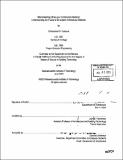| dc.contributor.advisor | John E. Fernandez. | en_US |
| dc.contributor.author | Carbone, Christopher M. (Christopher Martin), 1975- | en_US |
| dc.contributor.other | Massachusetts Institute of Technology. Dept. of Architecture. | en_US |
| dc.date.accessioned | 2011-07-18T14:03:12Z | |
| dc.date.available | 2011-07-18T14:03:12Z | |
| dc.date.copyright | 2003 | en_US |
| dc.date.issued | 2003 | en_US |
| dc.identifier.uri | http://hdl.handle.net/1721.1/64914 | |
| dc.description | Thesis (S.M.)--Massachusetts Institute of Technology, Dept. of Architecture, 2003. | en_US |
| dc.description | Includes bibliographical references (p. 143-158). | en_US |
| dc.description.abstract | There is a current trend in design and construction towards the use of distinct prefabricated components in the production of buildings. There is also a growing awareness by architects and builders of the environmental impact caused by the production, operation, and disposal of buildings. Since the industrial revolution, building materials have tended towards high-energy solutions, as materials of renewable origin are inherently difficult to manufacture to the tight tolerances demanded from modern design. Additionally, they are perceived as more susceptible to fire and rot than many synthetic materials. Yet, impending energy shortages as well as environmental concerns now force us to reconsider if there are ways to use renewable materials without compromising design. One such material worthy of reconsideration is straw; which has been used for thousands of years in architecture. Straw refers to the dried stems of grain bearing grasses, which are often burned or tilled back into the soil after the grain has been harvested. This paper will survey the current global production of straw and the environmental impact of straw use in construction. Further, it will identify future opportunities for the use of straw in modern design. Included is a design for a straw insulation system for commercial architecture. The system is comprised primarily of straw with a bio-based shell. This insulation system is designed for disassembly from the other building systems so that these organic materials can return to their natural cycles at the end of the use phase. A sample design is given to demonstrate its use in construction, and prototypes are built to test the feasibility of this design. Computer simulations are performed to demonstrate hygro-thermal response of this design to the climates of Boston, Massachusetts; Minneapolis, Minnesota; and Los Angeles, California. Preliminary thermal testing of the prototypes qualitatively indicates their effectiveness. The analysis is then expanded to a discussion of the link between global waste generation, resource consumption, and life spans of building systems. Finally, a simple method of classifying natural resources is presented which may help educate future generations to better understand the full ramifications of design and development, and a life cycle analysis of the designed component is performed using this new classification scheme. | en_US |
| dc.description.statementofresponsibility | by Christopher M. Carbone. | en_US |
| dc.format.extent | 158 p. | en_US |
| dc.language.iso | eng | en_US |
| dc.publisher | Massachusetts Institute of Technology | en_US |
| dc.rights | M.I.T. theses are protected by
copyright. They may be viewed from this source for any purpose, but
reproduction or distribution in any format is prohibited without written
permission. See provided URL for inquiries about permission. | en_US |
| dc.rights.uri | http://dspace.mit.edu/handle/1721.1/7582 | en_US |
| dc.subject | Architecture. | en_US |
| dc.title | Mainstreaming straw as a construction material : understanding the future of bio-based architectural materials | en_US |
| dc.type | Thesis | en_US |
| dc.description.degree | S.M. | en_US |
| dc.contributor.department | Massachusetts Institute of Technology. Department of Architecture | |
| dc.identifier.oclc | 53129680 | en_US |

